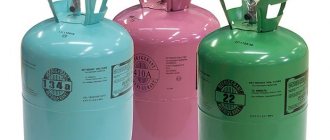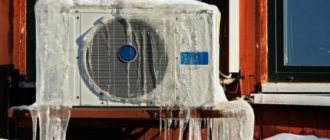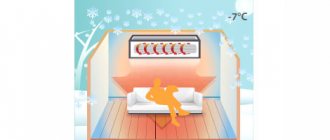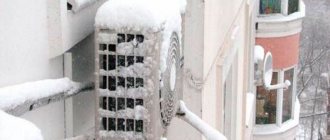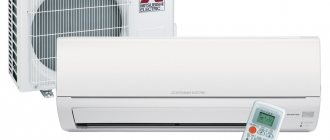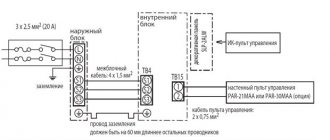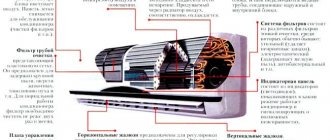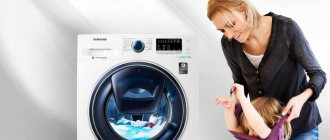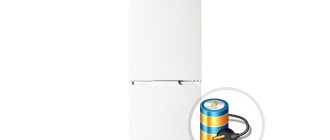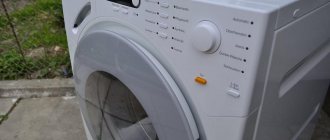Air conditioners and split systems with FREE installation
People often think that an air conditioner “eats” a lot of electricity. They believe that a 2.5-kilowatt system consumes the same amount per hour. This is not a heater, and the numbers are different.
A split system only needs electricity to operate the compressor and fan. Therefore, it consumes less electricity.
How much electricity does an air conditioner consume per hour?
There is a formula for calculation: the rated power of the split system divided by the EER coefficient. All this data is indicated in the instruction manual.
EER indicates how many times a device's power consumption is lower than its performance. The coefficient depends on the energy efficiency class. Most modern systems have class A, which corresponds to EER >3.20.
For example, the cold performance of an air conditioner is 2.5 kW, class A. We calculate its consumption per hour: 2.5 / 3.20 = 0.78 kilowatts.
Roughly speaking, a split system spends three times less than it produces. Therefore, to the question of how much an air conditioner consumes, the answer will be as follows:
- “sevens” – 0.65-0.75 kW/h;
- “nines” - about 0.78-0.88 kW/h;
- “twelve” - 0.96-1 kW/h.
Please note that the system does not operate continuously. When it reaches the desired temperature, it will turn off.
If the model is inverter, when the specified parameters are reached, the compressor will reduce speed to a minimum without turning off. Maintaining the temperature requires less energy than full cooling.
Manufacturers of inverter air conditioners claim that their devices consume 40% less electricity than conventional models. Thus, the inverter “nine” consumes approximately 500 W per hour.
More details Maintenance of air conditioners Price from 2,500 ₽
kW consumption calculations
Let's take an air conditioner (07) with a power of 2000 Watts, which means that it consumes 700 - 800 W/hour depending on the mode: heating or cooling the air, but if the air conditioner has an inverter compressor, then the consumption will decrease by another 30-50% and will be 350- 500 W/hour.
We recommend: How much electricity does a multicooker (steamer) consume?
Calculation of consumption for 1 minute: 500 (device power) / 60 (minutes in an hour) = 8.3 Watts/minute.
Let's say that you turn it on for 9 hours a day: 500(consumption per hour) * 9(number of operating hours) = 4500 W (4.5 kW/day).
Electricity consumption per month: 30 (days of operation) * 4.5 (consumption per day) = 135 kW/month.
The amount of payment for the electricity spent by the air conditioner: 135 * 3.5 rubles (for example, the tariff for 1 kW/hour, there are different tariffs in each region, district, city and village) = 472.5 rubles.
Attention, we calculated the consumption of a type 07 air conditioner with an inverter compressor for a 9-hour working day (in hot weather it can work for 18 hours and then the consumption will increase by 2 times), if you have the same type, but without an inverter, then the consumption will be 5, 85 kW per day, 175.5 kW per month.
How much does an air conditioner consume per month?
It all depends on the number of hours worked. If the weather is hot, the device can work up to 10-12 or more.
Let’s take the same “nine” as an example. An hour of operation requires 0.78 kW. In 6 hours, consumption will reach 4.68 kilowatts per day. In a month it will generate 140 kW when operating in this mode. If we take into account the tariff of 5.38 rubles for 2021, in rubles the figure will be an additional 753 rubles. per month.
This calculation is quite rough. It all depends on the area of the room, heat flow, desired parameters in the room, etc.
Technical condition of the air conditioner
The efficiency of an air conditioner very much depends on its technical condition and can sometimes drop almost to zero if the air conditioner is dirty or malfunctioning.
Air conditioner dirty
If the filters, fan and heat exchangers of the external and internal units of the split system are dirty, then the efficiency of the air conditioner decreases.
Moreover, if the pollution is very strong, then it is noticeable to the eye - the air conditioner blows “warm air”, and if it is not too strong, then no, but the air conditioner still treacherously increases the electricity meter.
The main recommendation in this case is to clean the filters more often.
Filters must be washed under running, not hot water; if necessary, you can use neutral detergents, such as dishwashing detergent.
We recommend: Installation of skirting boards and their varieties
The amount of freon in the air conditioner
The cooling efficiency of a room air conditioner also depends on the presence of freon in its refrigeration circuit.
Moreover, its quantity should be optimal for the refrigeration system.
The efficiency of the air conditioner drops both when freon leaks and when it is refilled!
The “bigger is better” principle does not apply to an air conditioner.
And even if the air conditioner cools normally, this does not mean that it is operating in its optimal mode.
The only way out for a non-specialist in this case would be to carry out regular maintenance.
Those who want to learn how to diagnose and repair an air conditioner on their own can study our constantly updated section “Do-it-yourself air conditioner repair”
Thermal insulation of copper tubes
The external and internal blocks of the split system are connected by tubes through which freon circulates; its temperature is much lower than the ambient temperature and therefore losses also occur through them.
And the longer the route, the greater the heat loss.
Thermal insulation on the tubes may not be partially applied during installation; birds love to peck at it, using it to insulate their nests, and it also loses its properties over time.
So you need to monitor the integrity of the thermal insulation and restore it.
How to reduce the electricity consumption of an air conditioner
Here are some simple ways to reduce costs:
- Choose an inverter model that consumes less electricity.
- If possible, cover windows with blinds or curtains to reduce heat gain from the sun in the room.
- Do not open windows to prevent hot air from entering.
- Optimal parameters are 22-23 C°. Reducing the temperature by a degree increases electricity consumption by 5-8%.
- Clean the filters and heat exchanger regularly. A dirty device takes a long time to reach the desired temperature.
- Do not open the doors to the refrigerated room to prevent the cold from escaping from the room.
As you can see, installing an air conditioner does not involve huge expenses. An extra thousand a month is a small price to pay for the comfort of your own home.
Read more Service maintenance of air conditioners Price from 500 ₽ for maintenance
Energy efficiency indicators
Most modern split systems combine the functions of cooling and heating air. In each of these modes, the equipment consumes a different amount of energy resources. The exact consumption depends on many factors.
Device energy efficiency factors
The ratio of the power produced by a device to the energy consumed, which is necessary for its generation, is called the energy efficiency coefficient. It is this indicator that expresses the energy efficiency of climate control equipment.
Split systems have two of them:
- Refrigeration coefficient. Allows you to determine the energy consumption required by the device in cooling mode.
- Thermal coefficient. Makes it possible to assess the level of energy consumption when operating for heating.
To calculate the energy efficiency coefficient, you need to know the parameters of consumed and produced power in different modes, indicated in the equipment characteristics.
It is worth considering that the COP (heating power) value usually exceeds the EER (cooling power) value. This is due to the operating characteristics of the compressor. While working, it heats up and transfers heat to the refrigerant circulating in the system. In heating mode, the heat generated by the compressor serves as an additional source of energy
For example, let's take one of the models of split systems from AUX - ASW-H07A4.
Let's calculate its EER using the following formula:
K = Q/N,
Where:
- K is the required value;
- Q – power of the device in cooling mode (amount of generated energy in kW);
- N – power consumption (the amount of energy taken from the network in kW).
We get: K = 2.1 / 0.65 = 3.23
Therefore, the EER of the model taken is 3.23. The higher the final indicator, the more economically the device uses electricity.
The thermal coefficient COP is calculated using a similar formula. These values must be indicated in the technical data sheet of the device. They can also be obtained from the sales consultant at the time of purchase.
The values of the split system power consumption and output declared by the manufacturer, as well as COP and EER, may differ to one degree or another from the real ones. It all depends on the conditions in which the device is operated.
At enterprises where testing and calculations of energy efficiency of equipment are carried out, conditions are close to ideal. In practice, they are not always observed.
Therefore, it is important to take into account some rules for operating air conditioners to prevent excessive consumption of electricity. We'll look at them in more detail a little later.
The parameters of the considered COP and EER coefficients are fundamental when dividing split systems into energy efficiency classes according to the generally accepted scale.
Energy efficiency classes of split systems
The level of efficiency or “anti-efficiency” of split systems, like many other household appliances, is clearly demonstrated by the energy efficiency scale.
The classification of energy efficiency parameters involves marking devices with special symbols - Latin letters from “A” to “G”. According to the requirements of international quality standards, the designation corresponding to the device must be present on the packaging
Since the category of climate control equipment under consideration is characterized by two types of output power, it is also assigned two energy efficiency classes. Of course, this applies only to those devices that are designed for both heating and cooling of rooms.
The most economical group of equipment is considered to be the models marked “A”, the most energy-consuming – “G”. As existing technologies are constantly improving, manufacturers have begun to produce devices whose efficiency exceeds Class A.
We recommend: Calculating the power of a kitchen hood, how to calculate it correctly
In this regard, the scale was expanded, adding the designations “A+”, “A++”, “A+++”. Such models are an order of magnitude more economical, but also much more expensive than others.
Factors of minor importance
In addition to coefficients and energy efficiency classes, there are a number of additional factors that influence how much electricity the split system will consume:
- compressor type;
- thermal power of the device;
- room area;
- difference between internal and external temperatures.
The air conditioner's flow rate is largely determined by the compressor installed in the device. The amount of energy required depends on the frequency of its rotation. Conventional mechanisms operate on a start/stop principle.
When the sensor detects temperature changes above or below specified levels, the electronic unit starts the engine. After reaching the desired temperature values, it turns off again. In standby mode, virtually no electricity is consumed.
Inverter models smoothly maintain the temperature within the specified values. Therefore, they do not need to completely cool the entire air volume the next time they are turned on. They consume almost half as much electricity, last longer, and can operate for heating even in severe frosts.
The scheme according to which inverter split systems operate is considered more efficient and economical. In these models, compressors operate non-stop, smoothly changing rotation speed and, accordingly, power consumption.
The only drawback of equipment with inverter compressors is the high price. However, judging by user reviews, it pays for itself quite quickly.
The larger the area the air conditioner serves, the higher its consumption will be and the greater the thermal power it should have. This parameter is measured in BTU and is designated in numbers - 7, 9, 12, 18, 24, etc.
For average apartments, the first three options are most suitable.
The rest are installed in large houses and administrative buildings:
- “Seven” corresponds to a value of 7000 BTU (1BTU ≈ 0.3 W). That is, its performance is approximately 2100 W. Such a unit can efficiently serve premises with an area of 20-25 m², while consuming about 0.7 kW/h.
- "Nine" has a power of 9000 BTU or 2700 watts. It is designed for objects with an area of 25-30 m² and consumes electricity within 0.8 kW/h.
- “Twelve” with a performance of 12000 BTU or 3600 W is intended for rooms up to 40 m². Its consumption is about 0.95-1 kW/h.
If you do not compare the thermal power of the device with the area of the room and buy an air conditioner with a lower value than is actually necessary, you may encounter unpleasant consequences.
First of all, this is fraught with increased energy consumption and a shortened service life of the device due to excessive loads.
To ensure uninterrupted and safe operation of the air conditioner, you should ensure that there is an outlet with a power coefficient corresponding to its power, check the parameters of the safety plugs in the electrical panel, and make sure that the wiring is in good technical condition
The temperature outside the window, or more precisely, its difference with the temperature in the room served, also affects the amount of energy consumption.
For example, the outdoor thermometers have risen to +40 °C, and the room needs to be cooled to 22 °C. In this case, the air conditioner will consume more energy than if it were 32 °C outside.


